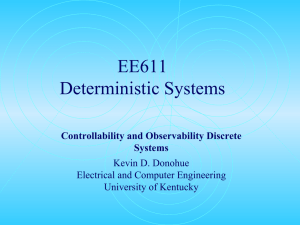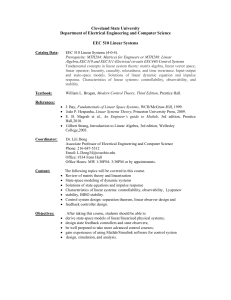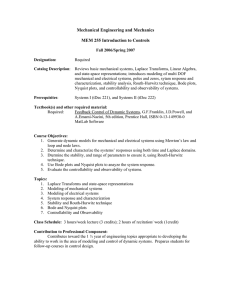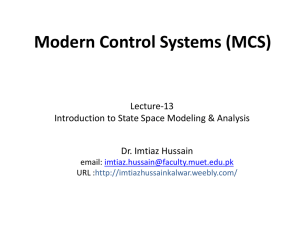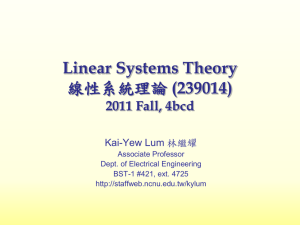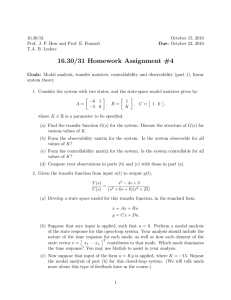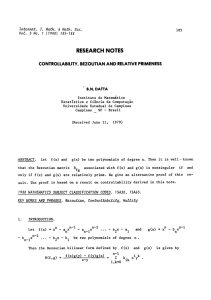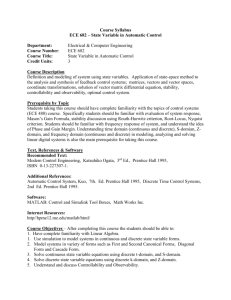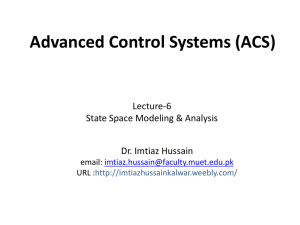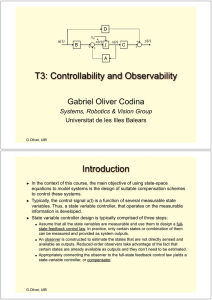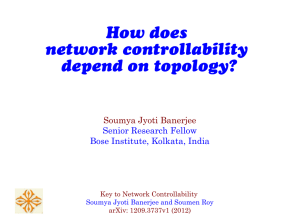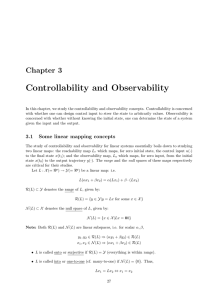Topic #10 16.30/31 Feedback Control Systems State-Space Systems
advertisement
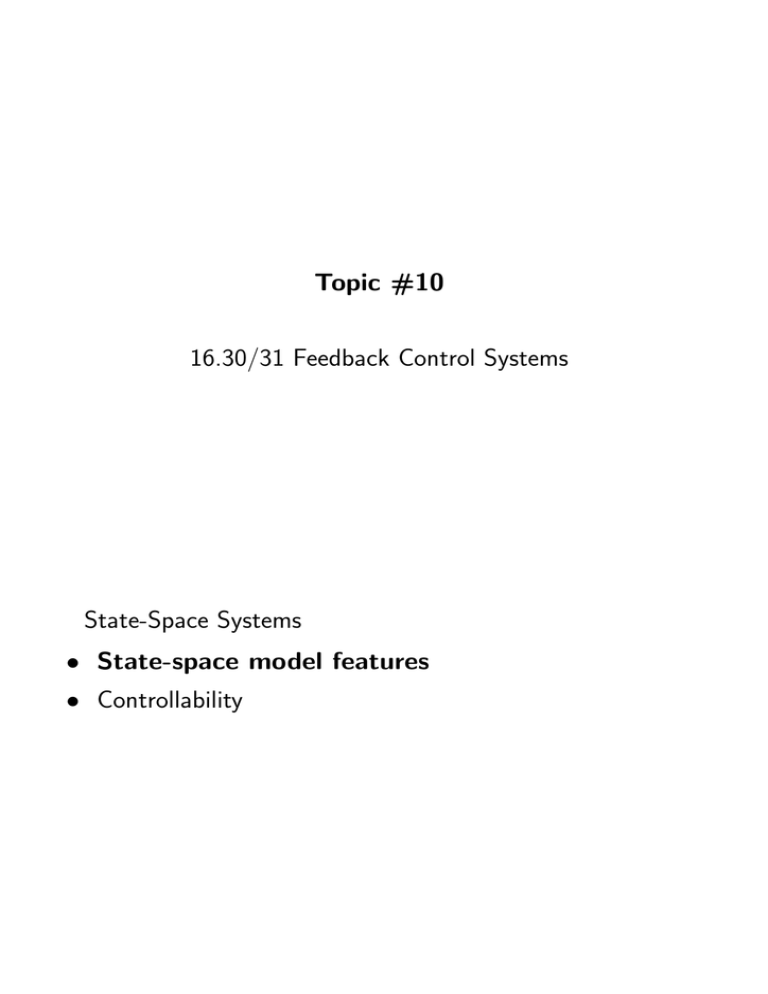
Topic #10 16.30/31 Feedback Control Systems State-Space Systems • State-space model features • Controllability Fall 2010 16.30/31 10–1 Controllability • Definition: An LTI system is controllable if, for every x�(t) and every finite T > 0, there exists an input function u(t), 0 < t ≤ T , such that the system state goes from x(0) = 0 to x(T ) = x�. • Starting at 0 is not a special case – if we can get to any state in finite time from the origin, then we can get from any initial condition to that state in finite time as well. 1 • This definition of controllability is consistent with the notion we used before of being able to “influence” all the states in the system in the decoupled examples (page 9–??). • ROT: For those decoupled examples, if part of the state cannot be “influenced” by u(t), then it would be impossible to move that part of the state from 0 to x� • Need only consider the forced solution to study controllability. � t xf (t) = eA(t−τ )Bu(τ )dτ 0 • Change of variables τ2 = t − τ , dτ = −dτ2 gives a form that is a little easier to work with: � t xf (t) = eAτ2 Bu(t − τ2)dτ2 0 • Assume system has m inputs. 1 This controllability from the origin is often called reachability. October 13, 2010 Fall 2010 16.30/31 10–2 • Note that, regardless of the eigenstructure of A, the Cayley-Hamilton theorem gives n−1 � At e = Aiαi(t) i=0 for some computable scalars αi(t), so that � t n−1 n−1 � � i xf (t) = (A B) αi(τ2)u(t − τ2)dτ2 = (AiB)β i(t) i=0 0 i=0 for coefficients β i(t) that depend on the input u(τ ), 0 < τ ≤ t. • Result can be interpreted as meaning that the state xf (t) is a linear combination of the nm vectors AiB (with m inputs). • All linear combinations of these nm vectors is the range space of the matrix formed from the AiB column vectors: � � 2 n−1 Mc = B AB A B · · · A B • Definition: Range space of Mc is controllable subspace of the system • If a state xc(t) is not in the range space of Mc, it is not a linear combination of these columns ⇒ it is impossible for xf (t) to ever equal xc(t) – called uncontrollable state. • Theorem: LTI system is controllable iff it has no uncontrol­ lable states. • Necessary and sufficient condition for controllability is that � � 2 n−1 rank Mc � rank B AB A B · · · A B = n October 13, 2010 Fall 2010 16.30/31 10–3 Further Examples • With Model # 2: � ¯˙ = x −2 0 � � � 2 x̄ + u 1 0 −1 � � ¯ y = 3 0 x � � � � C 3 0 M0 = = CA −6 0 � � � � 2 −4 Mc = B AB = 1 −1 • rank M0 = 1 and rank Mc = 2 • So this model of the system is controllable, but not observable. • With Model # 3: � ¯˙ = x −2 0 � � � 2 ¯ + x u 0 0 −1 � y = 3 2 x̄ � � � � C 3 2 M0 = = CA −6 −2 � � � � 2 −4 Mc = B AB = 0 0 � • rank M0 = 2 and rank Mc = 1 • So this model of the system is observable, but not controllable. • Note that controllability/observability are not intrinsic properties of a system. Whether the model has them or not depends on the repre­ sentation that you choose. • But they indicate that something else more fundamental is wrong. . . October 13, 2010 Fall 2010 16.30/31 10–4 Modal Tests • Earlier examples showed the relative simplicity of testing observabili­ ty/controllability for system with a decoupled A matrix. • There is, of course, a very special decoupled form for the state-space model: the Modal Form (6–??) • Assuming that we are given the model ẋ = Ax + Bu y = Cx + Du and the A is diagonalizable (A = T ΛT −1) using the transformation ⎡ ⎤ | | T = ⎣ v1 · · · vn ⎦ | | based on the eigenvalues of A. Note that we wrote: ⎡ ⎤ − w1T − ... ⎦ T −1 = ⎣ − wnT − which is a column of rows. • Then define a new state so that x = T z, then ż = T −1ẋ = T −1(Ax + Bu) = (T −1AT )z + T −1Bu = Λz + T −1Bu y = Cx + Du = CT z + Du October 13, 2010 Fall 2010 16.30/31 10–5 • The new model in the state z is diagonal. There is no coupling in the dynamics matrix Λ. • But by definition, ⎤ w1T T −1B = ⎣ ... ⎦ B wnT ⎡ and � CT = C v1 · · · vn � • Thus if it turned out that wiT B ≡ 0 then that element of the state vector zi would be uncontrollable by the input u. • Also, if Cvj ≡ 0 then that element of the state vector zj would be unobservable with this sensor. • Thus, all modes of the system are controllable and observ­ able if it can be shown that wiT B = � 0 ∀i and Cvj �= 0 ∀ j October 13, 2010 Fall 2010 16.30/31 10–6 Cancelation • Examples show the close connection between pole-zero cancelation and loss of observability and controllability. Can be strengthened. • Theorem: The mode (λi, vi) of a system (A, B, C, � D)� is unobserv­ vi able iff the system has a zero at λi with direction . 0 • Proof: If the system is unobservable at λi, then we know (λiI − A)vi = 0 It is a mode Cvi = 0 That mode is unobservable Combine to get: � Or � � (λiI − A) vi = 0 C �� � (λiI − A) −B vi =0 C D 0 which implies that � �the system has a zero at that frequency as well, vi with direction . 0 • Can repeat the process looking loss of controllability, but now � for � using zeros with left direction wiT 0 . October 13, 2010 Fall 2010 16.30/31 10–7 • Combined Definition: when a MIMO zero causes loss of either observability or controllability we say that there is a pole/zero cance­ lation. • MIMO pole-zero (right direction generalized eigenvector) cancela­ tion ⇔ mode is unobservable • MIMO pole-zero (left direction generalized eigenvector) cancela­ tion ⇔ mode is uncontrollable • Note: This cancelation requires an agreement of both the frequency and � �the directionality of the system mode (eigenvector) and zero � T � vi or wi 0 . 0 October 13, 2010 Fall 2010 16.30/31 10–8 Connection to Residue • Recall that in modal form, the state-space model (assumes diagonal­ izable) is given by the matrices ⎡ ⎤ ⎡ T ⎤ p1 w1 B � � . .. ⎦ B = ⎣ ... ⎦ C = Cv1 · · · Cvn A=⎣ pn wnT B for which case it can easily be shown that G(s) = C(sI − A)−1B ⎡ = = � �⎢ Cv1 · · · Cvn ⎣ 1 s−p1 ⎤⎡ ... 1 s−pn ⎥⎣ ⎦ w1T B ⎤ ... ⎦ wnT B n � (Cvi)(wT B) i i=1 s − pi • Thus the residue of each pole is a direct function of the product of the degree of controllability and observability for that mode. • Loss of observability or controllability ⇒ residue is zero ⇒ that pole does not show up in the transfer function. • If modes have equal observability Cvi ≈ Cvj , but one wiT B � wjT B then the residue of the ith mode will be much larger. • Great way to approach model reduction if needed. October 13, 2010 Fall 2010 16.30/31 10–9 Weaker Conditions • Often it is too much to assume that we will have full observability and controllability. Often have to make do with the following. System called: • Detectable if all unstable modes are observable • Stabilizable if all unstable modes are controllable • So if you had a stabilizable and detectable system, there could be dynamics that you are not aware of and cannot influence, but you know that they are at least stable. • That is enough information on the system model for now – will assume minimal models from here on and start looking at the control issues. October 13, 2010 MIT OpenCourseWare http://ocw.mit.edu 16.30 / 16.31 Feedback Control Systems Fall 2010 For information about citing these materials or our Terms of Use, visit: http://ocw.mit.edu/terms.
